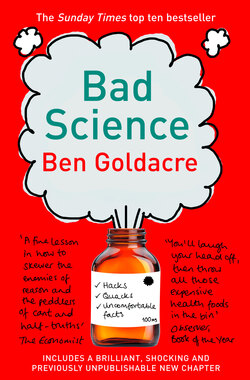Читать книгу Bad Science - Ben Goldacre - Страница 10
Ear candles
ОглавлениеYou might think that Hopi Ear Candles are an easy target. But their efficacy has still been cheerfully promoted by the Independent, the Observer and the BBC, to name just a few respected news outlets. Since these people are the authoritative purveyors of scientific information, I’ll let the BBC explain how these hollow wax tubes will detox your body:
The candles work by vaporising their ingredients once lit, causing convectional air flow towards the first chamber of the ear. The candle creates a mild suction which lets the vapours gently massage the eardrum and auditory canal. Once the candle is placed in the ear it forms a seal which enables wax and other impurities to be drawn out of the ear.
The proof comes when you open a candle up, and discover that it is filled with a familiar waxy orange substance, which must surely be earwax. If you’d like to test this yourself, you will need: an ear, a clothes peg, some Blu Tack, a dusty floor, some scissors, and two ear candles. I recommend OTOSAN because of their strapline (‘The ear is the gateway to the soul’).
If you light one ear candle, and hold it over some dust, you will find little evidence of any suction. Before you rush to publish your finding in a peer-reviewed academic journal, someone has beaten you to it: a paper published in the medical journal Laryngoscope used expensive tympanometry equipment and found—as you have—that ear candles exert no suction. There is no truth to the claim that doctors dismiss alternative therapies out of hand.
But what if the wax and toxins are being drawn into the candle by some other, more esoteric route, as is often claimed? For this you will need to do something called a controlled experiment, comparing the results of two different situations, where one is the experimental condition, the other is the ‘control’ condition, and the only difference is the thing you’re interested in testing. This is why you have two candles.
Put one ear candle in someone’s ear, as per the manufacturer’s instructions, and leave it there until it burns down.* Put the other candle in the clothes peg, and stand it upright using the Blu Tack: this is the ‘control arm’ in your experiment. The point of a control is simple: we need to minimise the differences between the two set-ups, so that the only real difference between them is the single factor you’re studying, which in this case must be: ‘Is it my ear that produces the orange goo?’
Take your two candles back inside and cut them open. In the ‘ear’ candle, you will find a waxy orange substance. In the ‘picnic table control’, you will find a waxy orange substance. There is only one internationally recognised method for identifying something as earwax: pick some up on the end of your finger, and touch it with your tongue. If your experiment had the same results as mine, both of them taste a lot like candle wax.
Does the ear candle remove earwax from your ears? You can’t tell, but a published study followed patients during a full programme of ear candling, and found no reduction. For all that you might have learnt something useful here about the experimental method, there is something more significant you should have picked up: it is expensive, tedious and time-consuming to test every whim concocted out of thin air by therapists selling unlikely miracle cures. But it can be done, and it is done.
